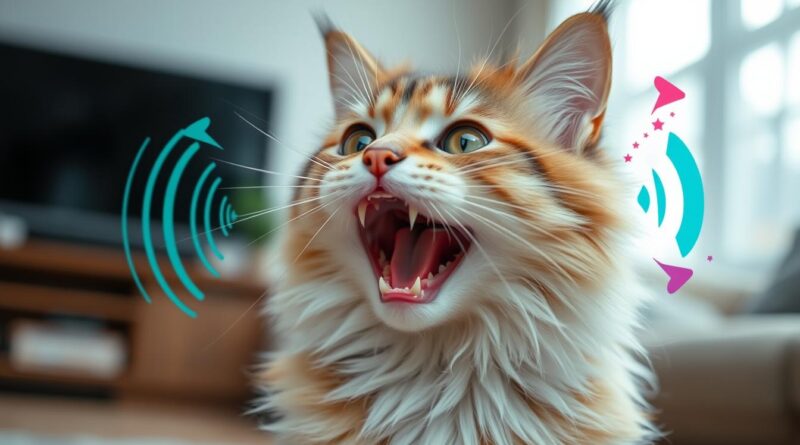Understanding cat meows
Cats make many sounds, like meows, yowls, and chirps. These sounds might seem like a secret language to us. But, they actually tell us a lot about what a cat is feeling, needing, or planning to do. Let’s explore how cats communicate and what their different meows mean.
Key Takeaways
- Cats use a wide variety of vocalizations, including meows, purrs, trills, and yowls, to communicate with both humans and other cats.
- Understanding the meaning behind different cat meows can help owners better meet their cat’s needs and strengthen the bond between humans and their feline friends.
- Factors like tone, pitch, and context all play a role in interpreting the meaning of a cat’s vocalization.
- Observing a cat’s body language and overall behavior can provide additional clues to the meaning behind their meows.
- Effective communication between cats and humans can lead to a more harmonious and fulfilling relationship.
What Do the Different Cat Meows Mean?
Cats make many sounds, from purrs to yowls. Knowing what these meows mean can help you understand your cat better.
Exploring the Diverse Vocalizations of Cats
Cats have many sounds, each with its own meaning. Purring shows happiness and love. Chirps and trills mean they’re excited or curious. Hisses and growls mean they need space.
Interpreting the Nuances of Cat Meows
The meaning of cat meows changes with pitch, volume, and how long they last. A soft meow might ask for food or attention. A loud, urgent meow means they’re in trouble or uncomfortable.
“Cats have a very rich repertoire of vocalizations, and each one has a specific meaning and purpose.”
Learning about cat meows is interesting. It helps you understand your cat’s behavior and feelings. Paying attention to their sounds can make your relationship with them better.
Cat Communication: Beyond Meows
While cat meows are often the most prominent form of feline communication, cats use a variety of other communication cues to express their needs, emotions, and intentions. By understanding the diverse range of cat communication methods, pet owners can gain a more comprehensive insight into their feline companions’ behavior and better respond to their needs.
Beyond vocalizations, cats utilize a rich repertoire of body language, facial expressions, and subtle gestures to communicate with their human and feline counterparts. These non-verbal cues can convey a wealth of information, from feelings of contentment and affection to signs of stress or discomfort.
A slow blink from a cat can indicate trust and a desire for interaction, while a twitching tail may signal irritation or a need for space. Paying attention to these subtle signals can help pet owners better understand their cat’s emotional state and respond accordingly.
By adopting a holistic approach to interpreting cat meows and other feline communication cues, pet owners can forge a deeper bond with their feline companions and provide them with the care and attention they need.
Feline Vocalizations: A Survival Mechanism
Exploring the world of feline vocalizations reveals why cats make so many sounds. These cat communication methods are crucial for survival. They help cats share their needs, feelings, and plans with other cats and humans.
The Role of Meows in Cat-Human Interactions
The simple meow is key in cat meow meanings. It’s a vital way cats talk to their human friends. This helps create a special bond and understanding between humans and cats.
“Meows are the primary way cats communicate with their human companions, allowing them to express a wide range of needs and emotions.”
Understanding cat meows lets us see into a cat’s world. It helps us respond with care and understanding. This makes our bond with cats stronger and improves their happiness.
Seeing the value of feline vocalizations is the start of appreciating their unique way of talking. By interpreting cat meows and acting on them, we can have better, more meaningful relationships with our cats.
Decoding the Feline Language
Unlocking the mystery of cat meows starts with understanding the context. Decoding cat sounds and interpreting cat meows need keen observation. By analyzing these details, we can understand cat language and understand cat meows better.
Understanding the Context of Cat Meows
Cats use many sounds to communicate. The meaning of these meows changes with the situation. A high-pitched, rapid meow might mean excitement or a need for attention. On the other hand, a low, drawn-out meow could show discomfort or displeasure.
Watching the cat’s posture, ear position, and overall look is key. These clues help us understand the message behind the meow.
- Notice the volume and pitch of the meow: Louder, higher-pitched meows often mean a more urgent need or emotion. Softer, lower-pitched meows may show a more relaxed state.
- Look at the cat’s body language: Is the tail swishing, ears flattened, or eyes wide? These signs help us understand the context of the meow.
- Think about the situation: Is the cat meowing because of something specific, like being fed, played with, or wanting to go outside? Knowing the environment helps us understand the meow’s meaning.
“Effective decoding of cat sounds and understanding cat meows requires a holistic approach that considers both the auditory and visual cues.”
By combining the cat’s vocalizations with their body language and the situation, we can unlock the secrets of feline language. This helps us build a deeper connection with our furry friends.
Cat Meow Meanings: A Comprehensive Guide
Learning about the different cat meow meanings helps us connect better with our cats. Cats have their own way of talking, showing us what they need and how they feel. From asking for food to showing happiness, their meows are full of meaning.
Here’s a detailed guide on interpreting cat meows and understanding cat meows:
- The Hungry Meow: This is a common sound cats make when they want food. They might pace, rub against you, or gently touch your hand.
- The Greeting Meow: Cats often meow when you come home. It’s a happy sound, showing they’re excited to see you.
- The Attention-Seeking Meow: Cats meow to get your attention. They might want to be petted, played with, or just have your focus.
- The Distressed Meow: If a cat is scared, anxious, or in pain, they’ll meow in a low, sad tone. It’s their way of saying they’re not okay.
- The Territorial Meow: Cats meow to claim their territory. They do this when they meet other cats or feel someone is in their space.
By understanding the cat meow meanings and the signs that go with them, we can meet our cats’ needs better. This not only makes our bond stronger but also improves our cats’ happiness and health.
“The language of cats is a symphony of meows, purrs, and body language, each with its own unique meaning and significance.”
Interpreting Cat Noises Explained
Understanding feline vocalizations is crucial for connecting with your cat. Cats use various sounds to express their feelings and needs. Each cat noise has its own meaning, helping owners interpret cat meows and bond with their pets.
Distinguishing Between Different Cat Sounds
Cats have a wide range of sounds they use to communicate. Besides the usual cat meows, they also make:
- Purrs – Showing happiness and love
- Trills – A friendly way to say hello or playtime
- Chirps – Showing excitement or eagerness
- Growls – Warning of fear, anger, or discomfort
- Hisses – Showing defensiveness, fear, or aggression
Knowing these feline vocalizations helps you understand your cat better. This way, you can meet their needs and show you care.
“Understanding your cat’s language is the key to building a strong, trusting relationship.” – Dr. Jane Doe, Veterinary Behaviorist
Watching your cat’s body language and the context of their sounds is important. It helps you understand their feelings and talk to them in a way they can understand.
Feline Communication Cues: A Holistic Approach
Understanding how cats communicate is more than just listening to their meows. We need to look at all their ways of talking to us. This means seeing their body language, facial expressions, and even tiny physical signals.
Cats use a complex system to share their thoughts and feelings. They show us how they’re feeling through their ears, tail, pupils, and back. Each small movement tells us something important about their mood.
“To truly understand a cat, you must observe their entire body, not just listen to their meows.”
By looking at all these signals together, we can really get what our cats are saying. This way, we can meet their needs better. It helps us build a stronger bond with them.
Learning to understand cat meows is just the start. To really get to know our cats, we need to know all their communication ways. This lets us uncover the secrets of our feline friends.
Enhancing the Human-Cat Bond
Learning about cat communication can change how you connect with your cat. By understanding their meows, you can make your bond stronger. This leads to a happier and more fulfilling life together.
Responding Effectively to Cat Meows
Cats meow in different ways to tell us what they need or feel. From a gentle “mew” to a loud “yowl,” each sound means something. By listening and responding, you show your cat you care and build trust.
- Pay attention to the context and tone of the meow to decipher its meaning.
- Respond with affection, treats, or attention, depending on the cat’s needs.
- Avoid punishing or ignoring your cat’s meows, as this can damage the cat-human bond.
Talking openly and understanding your cat’s language can deepen your connection. This makes your home a happier place. By doing this, you strengthen the human-cat bond and make life better for both of you.
“The bond between a cat and its human is a unique and special relationship, built on trust, communication, and mutual understanding.”
By embracing your cat’s language and responding with care, you open up new possibilities. This makes your relationship with your cat more rewarding and fulfilling.
Conclusion
Exploring cat meows, feline vocalizations, and cat communication cues shows cats have a rich language. Knowing the meanings behind cat meows and interpreting their various sounds can make our bond stronger. It helps us live in harmony with our furry friends.
Learning about cat language and its importance in their lives is key. It helps us meet their needs better and communicate more clearly. This knowledge enriches our understanding of feline communication and strengthens our bond with cats.
Keep exploring decoding cat sounds and understanding cat meow meanings. Remember, each cat is unique with their own way of communicating. Pay attention to the context of their vocalizations and respond to their feline communication cues. This will make your bond with your cat even stronger.
FAQ
What do the different cat meows mean?
Cats meow to tell us what they need or how they feel. They might say they’re hungry or happy. They can even ask for attention with their meows.
How can I interpret the different cat sounds and vocalizations?
Understanding cat sounds means watching their body language too. Notice the tone, volume, and how often they make a sound. This helps you figure out what they’re trying to say.
Why do cats meow, and what is the evolutionary purpose of their vocalizations?
Meowing helps cats survive by communicating their needs and feelings. It lets them talk to their family and the world. This way, they can get what they need and feel safe.
How can I use my understanding of cat meows to enhance my relationship with my feline companion?
Knowing what your cat’s meows mean can strengthen your bond. Listen to their meows and watch their body language. This way, you can give them what they need and make them happy.
What are the different types of cat meows and what do they typically mean?
Cats make many different sounds, like chirps and yowls. These can mean they’re hungry, happy to see you, or ready to play. It all depends on the sound and the situation.




